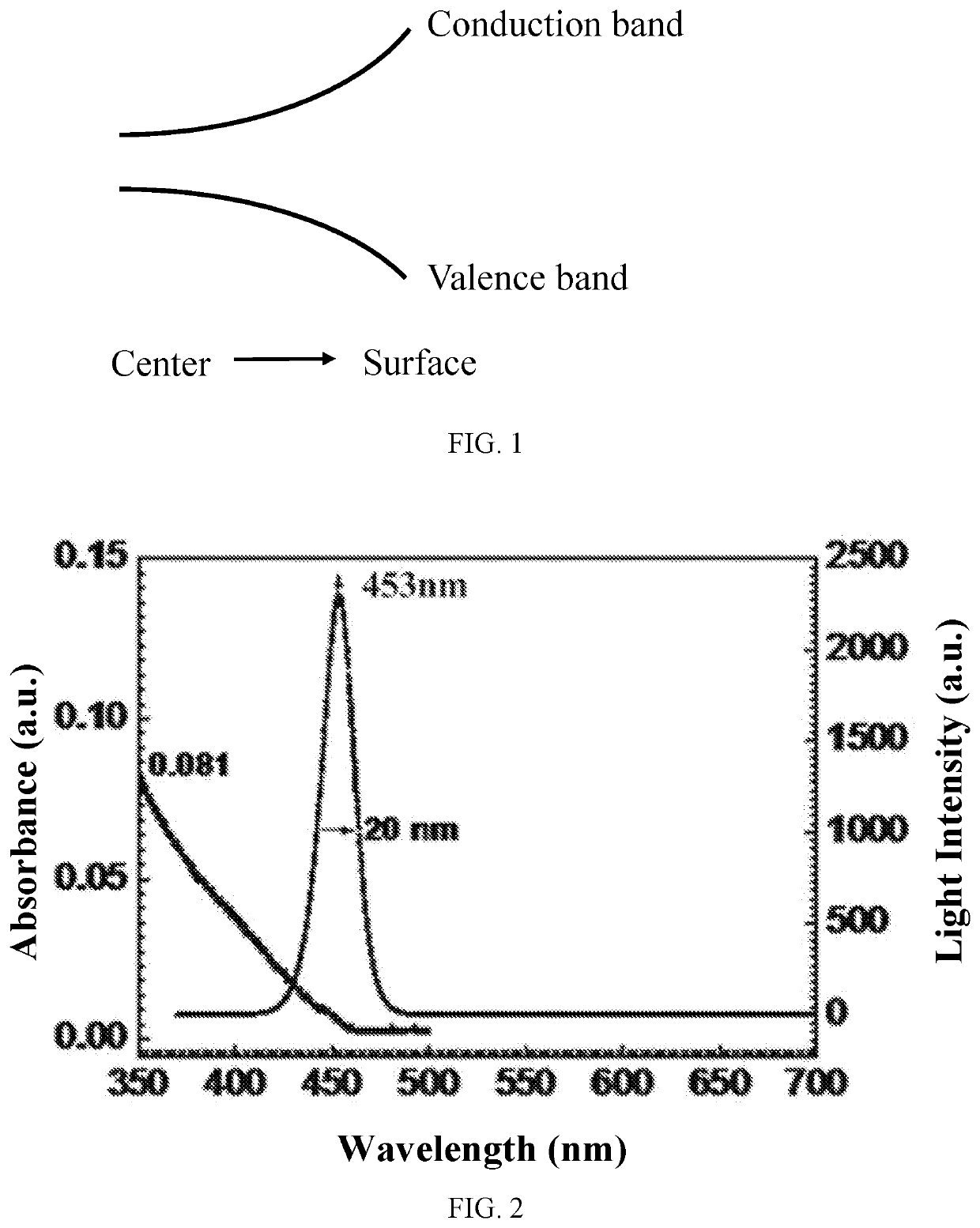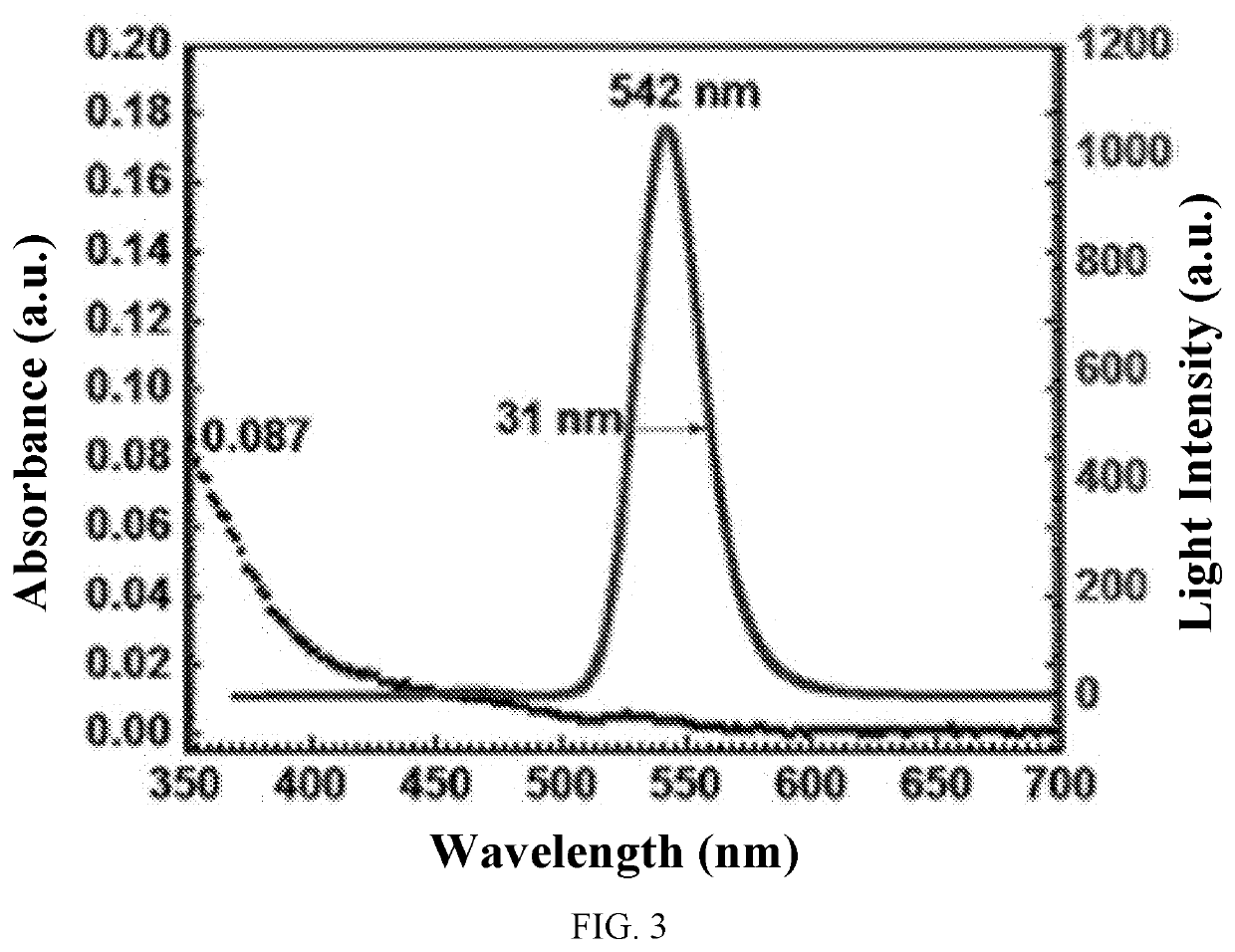Quantum dot material, preparation method, and semiconductor device
a technology of quantum dots and light-emitting materials, applied in the field of quantum dots, can solve the problems of reducing the research time on utilizing the excellent light-emitting properties of qds and using them as light-emitting materials in qled devices and corresponding displays, and reducing the application prospects of qd light-emitting display technologies. , to achieve the effect of high qd light-emission efficiency
- Summary
- Abstract
- Description
- Claims
- Application Information
AI Technical Summary
Benefits of technology
Problems solved by technology
Method used
Image
Examples
embodiment 1
of a CdZnSeS / CdZnSeS-Based QD
[0100]First, a cationic cadmium precursor, a cationic zinc precursor, an anionic selenium precursor, and an anionic sulfur precursor may be injected into a reaction system to form a CdyZn1-ySebS1-b layer, where 0≤y≤1, 0≤b≤1. Further, the cationic cadmium precursor, the cationic zinc precursor, the anionic selenium precursor, and the anionic sulfur precursor may be continuously injected into the reaction system to form a CdzZn1-zSecS1-c layer on the surface of the CdyZn1-ySebS1-b layer, where 0≤z≤1, 0≤c≤1, and z is not equal to y. Under certain reaction conditions including an appropriate heating temperature and an appropriate heating time, exchanges between Cd ions and Zn ions may take place in the inner and the outer nanocrystals (i.e., the two layers of compounds). Moreover, the migration distance of the cations is limited, and the migration probability decreases as the migration distance increases. Therefore, a gradient alloy composition distribution ...
embodiment 2
of a CdZnS / CdZnS-Based QD
[0101]First, a cationic cadmium precursor, a cationic zinc precursor, and an anionic sulfur precursor may be injected into a reaction system to form a CdyZn1-yS layer, where 0≤y≤1. Further, the cationic cadmium precursor, the cationic zinc precursor, and the anionic sulfur precursor may be continuously injected into the reaction system to form a CdzZn1-zS layer on the surface of the CdyZn1-yS layer, where 0≤z≤1, and z is not equal to y. Under certain reaction conditions including an appropriate heating temperature and an appropriate heating time, exchanges between Cd ions and Zn ions may take place in the inner and the outer nanocrystals (i.e., the two layers of compounds). Moreover, the migration distance of the cations is limited, and the migration probability decreases as the migration distance increases. Therefore, a gradient alloy composition distribution with varying Cd and Zn concentrations, i.e., CdxZn1-xS, where 0≤x≤1, may be formed at the interface...
embodiment 3
of a CdZnSe / CdZnSe-Based QD
[0102]First, a cationic cadmium precursor, a cationic zinc precursor, and an anionic selenium precursor may be injected into a reaction system to form a CdyZn1-ySe layer, where 0≤y≤1. Further, the cationic cadmium precursor, the cationic zinc precursor, and the anionic selenium precursor may be continuously injected into the reaction system to form a CdzZn1-zSe layer on the surface of the CdyZn1-ySe layer, where 0≤z≤1, and z is not equal to y. Under certain reaction conditions including an appropriate heating temperature and an appropriate heating time, exchanges between Cd ions and Zn ions may take place in the inner and the outer nanocrystals (i.e., the two layers of compounds). Moreover, the migration distance of the cations is limited, and the migration probability decreases as the migration distance increases. Therefore, a gradient alloy composition distribution with varying Cd and Zn concentrations, i.e., CdxZn1-xSe, where 0≤x≤1, may be formed at the...
PUM
| Property | Measurement | Unit |
|---|---|---|
| light-emission peak wavelength | aaaaa | aaaaa |
| full width at half maximum | aaaaa | aaaaa |
| temperature | aaaaa | aaaaa |
Abstract
Description
Claims
Application Information
 Login to View More
Login to View More - R&D
- Intellectual Property
- Life Sciences
- Materials
- Tech Scout
- Unparalleled Data Quality
- Higher Quality Content
- 60% Fewer Hallucinations
Browse by: Latest US Patents, China's latest patents, Technical Efficacy Thesaurus, Application Domain, Technology Topic, Popular Technical Reports.
© 2025 PatSnap. All rights reserved.Legal|Privacy policy|Modern Slavery Act Transparency Statement|Sitemap|About US| Contact US: help@patsnap.com



